2006 DODGE RAM SRT-10 tow
[x] Cancel search: towPage 4442 of 5267
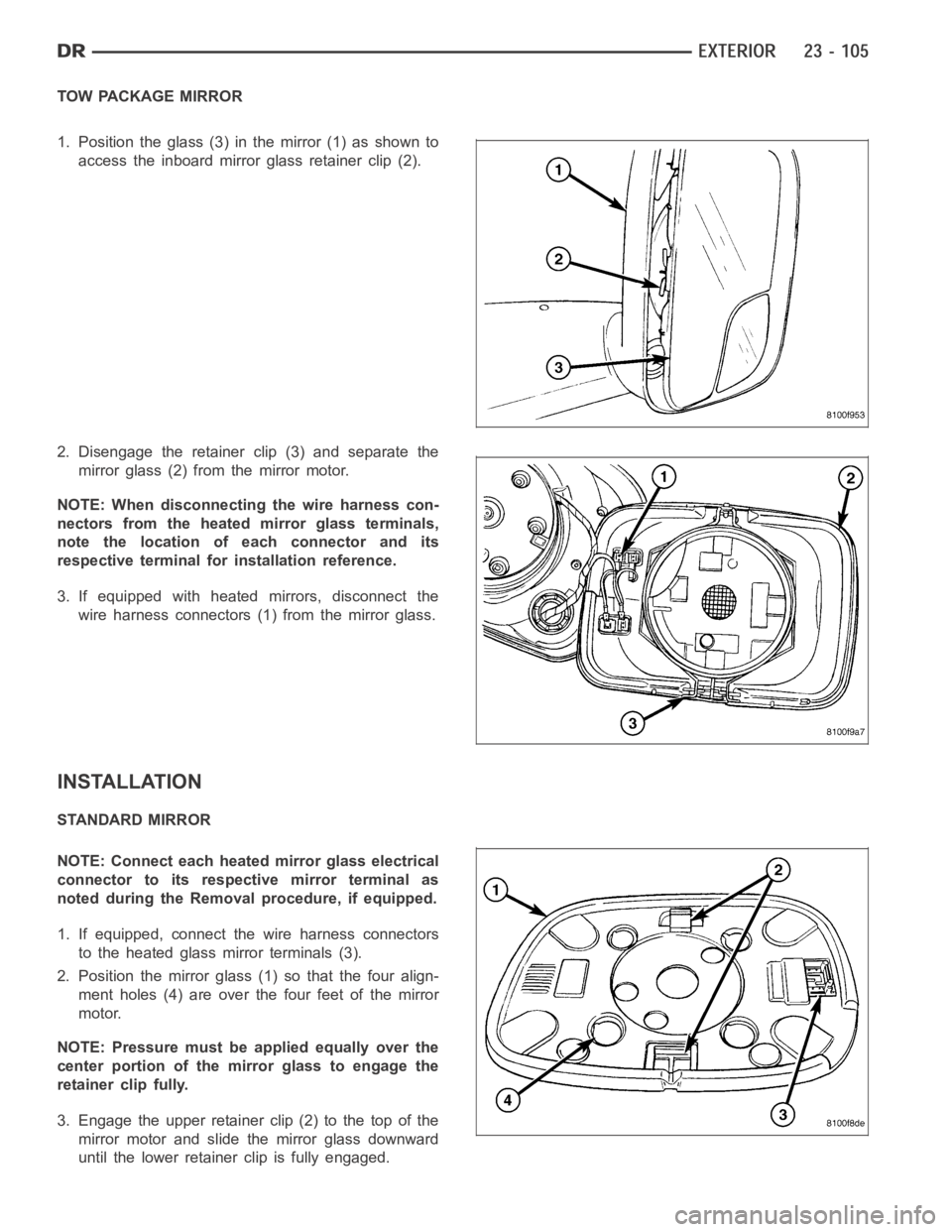
TOW PACKAGE MIRROR
1. Position the glass (3) in the mirror (1) as shown to
access the inboard mirror glass retainer clip (2).
2. Disengage the retainer clip (3) and separate the
mirror glass (2) from the mirror motor.
NOTE: When disconnecting the wire harness con-
nectors from the heated mirror glass terminals,
note the location of each connector and its
respective terminal for installation reference.
3. If equipped with heated mirrors, disconnect the
wire harness connectors (1) from the mirror glass.
INSTALLATION
STANDARD MIRROR
NOTE: Connect each heated mirror glass electrical
connector to its respective mirror terminal as
noted during the Removal procedure, if equipped.
1. If equipped, connect the wire harness connectors
to the heated glass mirror terminals (3).
2. Position the mirror glass (1) so that the four align-
ment holes (4) are over the four feet of the mirror
motor.
NOTE: Pressure must be applied equally over the
center portion of the mirror glass to engage the
retainer clip fully.
3. Engage the upper retainer clip (2) to the top of the
mirror motor and slide the mirror glass downward
until the lower retainerclip is fully engaged.
Page 4443 of 5267
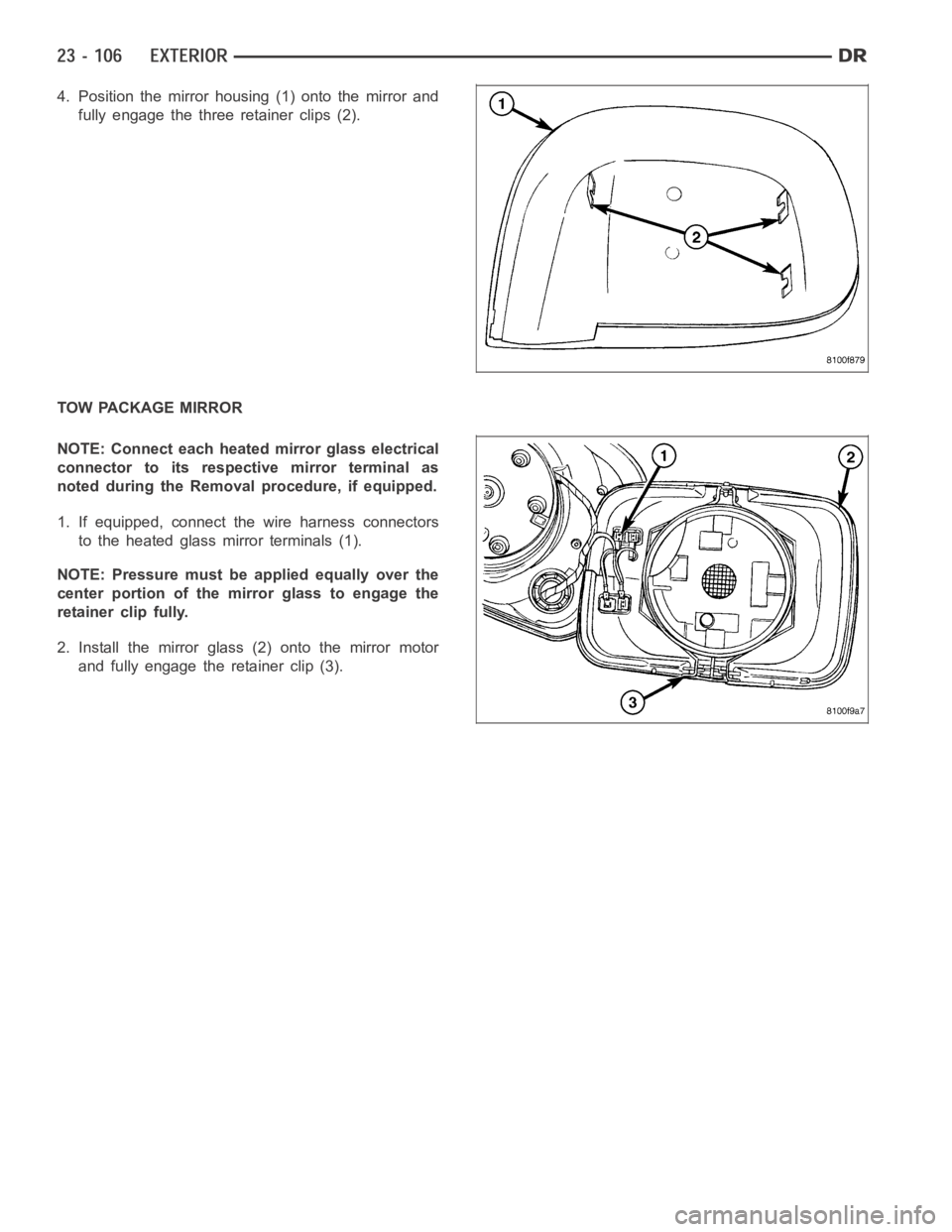
4. Position the mirror housing (1) onto the mirror and
fully engage the three retainer clips (2).
TOW PACKAGE MIRROR
NOTE: Connect each heated mirror glass electrical
connector to its respective mirror terminal as
noted during the Removal procedure, if equipped.
1. If equipped, connect the wire harness connectors
to the heated glass mirror terminals (1).
NOTE: Pressure must be applied equally over the
center portion of the mirror glass to engage the
retainer clip fully.
2. Install the mirror glass (2) onto the mirror motor
and fully engage the retainer clip (3).
Page 4465 of 5267
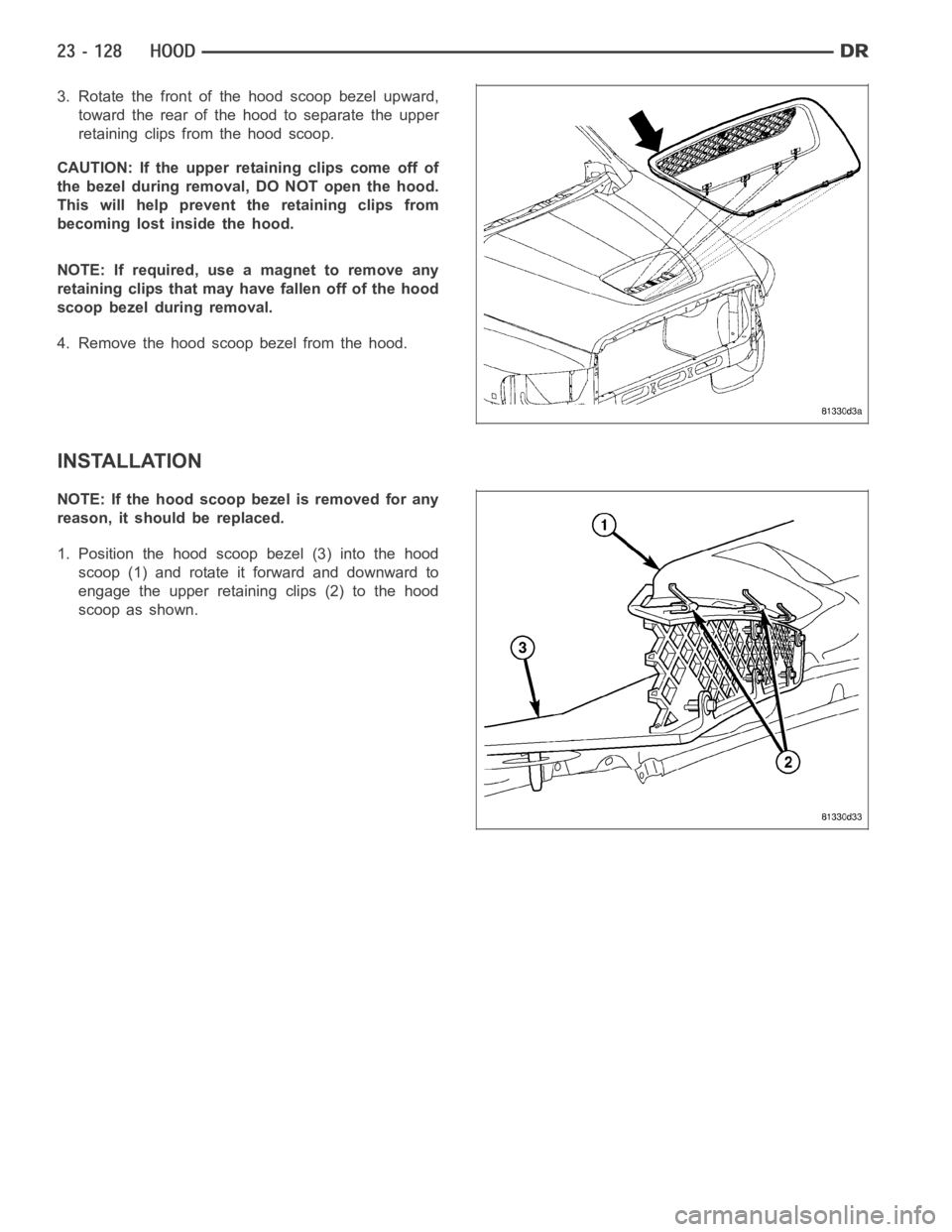
3. Rotate the front of the hood scoop bezel upward,
toward the rear of the hood to separate the upper
retaining clips from the hood scoop.
CAUTION: If the upper retaining clips come off of
the bezel during removal, DO NOT open the hood.
This will help prevent the retaining clips from
becoming lost inside the hood.
NOTE: If required, use a magnet to remove any
retaining clips that may have fallen off of the hood
scoop bezel during removal.
4. Remove the hood scoop bezel from the hood.
INSTALLATION
NOTE: If the hood scoop bezel is removed for any
reason, it should be replaced.
1. Position the hood scoop bezel (3) into the hood
scoop (1) and rotate it forward and downward to
engage the upper retaining clips (2) to the hood
scoop as shown.
Page 4547 of 5267
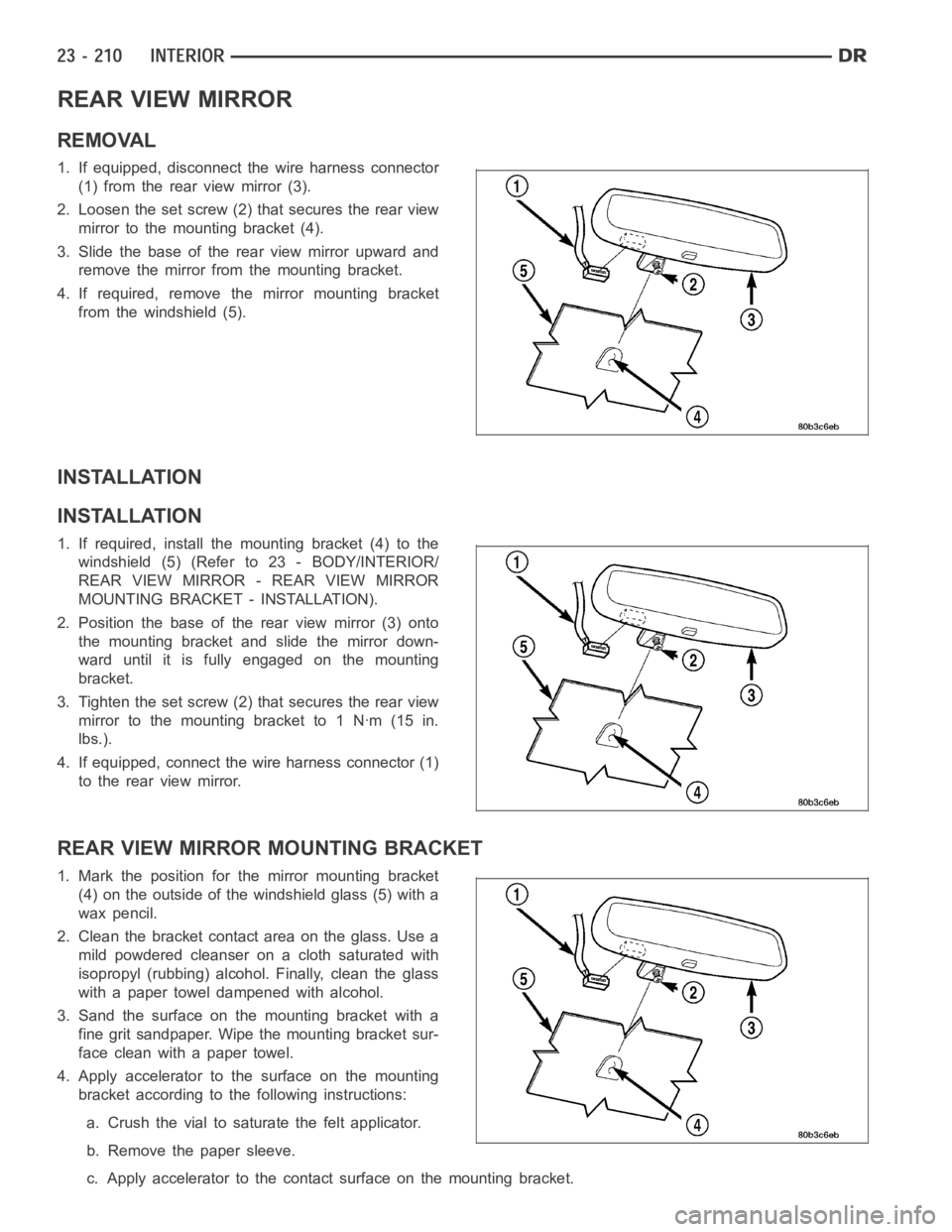
REAR VIEW MIRROR
REMOVAL
1. If equipped, disconnect the wire harness connector
(1) from the rear view mirror (3).
2. Loosen the set screw (2) that secures the rear view
mirror to the mounting bracket (4).
3. Slide the base of the rear view mirror upward and
remove the mirror from the mounting bracket.
4. If required, remove the mirror mounting bracket
from the windshield (5).
INSTALLATION
INSTALLATION
1. If required, install the mounting bracket (4) to the
windshield (5) (Refer to 23 - BODY/INTERIOR/
REAR VIEW MIRROR - REAR VIEW MIRROR
MOUNTING BRACKET - INSTALLATION).
2. Position the base of the rear view mirror (3) onto
the mounting bracket and slide the mirror down-
ward until it is fully engaged on the mounting
bracket.
3. Tighten the set screw (2) that secures the rear view
mirrortothemountingbracketto1Nꞏm(15in.
lbs.).
4. If equipped, connect the wire harness connector (1)
to the rear view mirror.
REAR VIEW MIRROR MOUNTING BRACKET
1.Markthepositionforthemirrormountingbracket
(4) on the outside of the windshield glass (5) with a
wax pencil.
2. Clean the bracket contact area on the glass. Use a
mild powdered cleanser on a cloth saturated with
isopropyl (rubbing) alcohol. Finally, clean the glass
with a paper towel dampened with alcohol.
3. Sand the surface on the mounting bracket with a
fine grit sandpaper. Wipe the mounting bracket sur-
face clean with a paper towel.
4. Apply accelerator to the surface on the mounting
bracket according to the following instructions:
a. Crush the vial to saturate the felt applicator.
b. Remove the paper sleeve.
c. Apply accelerator to the contact surface on the mounting bracket.
Page 4609 of 5267
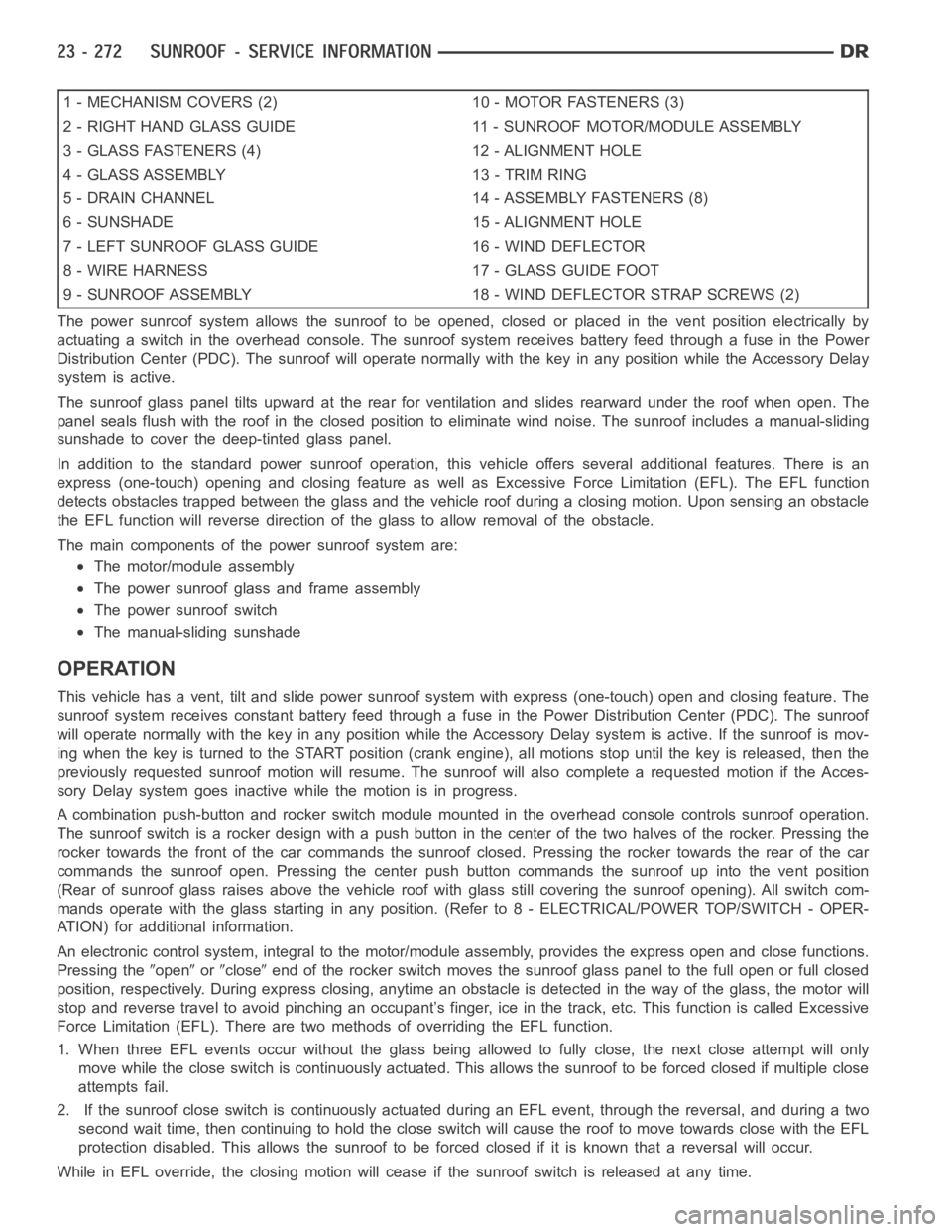
1 - MECHANISM COVERS (2) 10 - MOTOR FASTENERS (3)
2 - RIGHT HAND GLASS GUIDE 11 - SUNROOF MOTOR/MODULE ASSEMBLY
3 - GLASS FASTENERS (4) 12 - ALIGNMENT HOLE
4 - GLASS ASSEMBLY 13 - TRIM RING
5 - DRAIN CHANNEL 14 - ASSEMBLY FASTENERS (8)
6 - SUNSHADE 15 - ALIGNMENT HOLE
7 - LEFT SUNROOF GLASS GUIDE 16 - WIND DEFLECTOR
8 - WIRE HARNESS 17 - GLASS GUIDE FOOT
9 - SUNROOF ASSEMBLY 18 - WIND DEFLECTOR STRAP SCREWS (2)
The power sunroof system allows the sunroof to be opened, closed or placed in the vent position electrically by
actuating a switch in the overhead console. The sunroof system receives battery feed through a fuse in the Power
Distribution Center (PDC). The sunroof will operate normally with the keyin any position while the Accessory Delay
system is active.
The sunroof glass panel tilts upward at the rear for ventilation and slidesrearward under the roof when open. The
panel seals flush with the roof in the closed position to eliminate wind noise. The sunroof includes a manual-sliding
sunshade to cover the deep-tinted glass panel.
In addition to the standard power sunroof operation, this vehicle offers several additional features. There is an
express (one-touch) opening and closing feature as well as Excessive Force Limitation (EFL). The EFL function
detects obstacles trapped between the glass and the vehicle roof during a closing motion. Upon sensing an obstacle
the EFL function will reverse direction of the glass to allow removal of theobstacle.
The main components of thepower sunroof system are:
The motor/module assembly
The power sunroof glass and frame assembly
The power sunroof switch
The manual-sliding sunshade
OPERATION
This vehicle has a vent, tilt and slide power sunroof system with express (one-touch) open and closing feature. The
sunroof system receives constant battery feed through a fuse in the Power Distribution Center (PDC). The sunroof
will operate normally with the key in any position while the Accessory Delay system is active. If the sunroof is mov-
ing when the key is turned to the START position (crank engine), all motionsstop until the key is released, then the
previously requested sunroof motion will resume. The sunroof will also complete a requested motion if the Acces-
sory Delay system goes inactivewhile the motion is in progress.
A combination push-button and rocker switch module mounted in the overhead console controls sunroof operation.
The sunroof switch is a rocker design with a push button in the center of the two halves of the rocker. Pressing the
rocker towards the front of the car commands the sunroof closed. Pressing the rocker towards the rear of the car
commands the sunroof open. Pressing the center push button commands the sunroof up into the vent position
(Rear of sunroof glass raises above the vehicle roof with glass still covering the sunroof opening). All switch com-
mands operate with the glass startingin any position. (Refer to 8 - ELECTRICAL/POWER TOP/SWITCH - OPER-
ATION) for additional information.
An electronic control system, integralto the motor/module assembly, provides the express open and close functions.
Pressing the
openorcloseend of the rocker switch moves the sunroof glass panel to the full open or fullclosed
position, respectively. During express closing, anytime an obstacle is detected in the way of the glass, the motor will
stop and reverse travel to avoid pinching an occupant’s finger, ice in the track, etc. This function is called Excessive
Force Limitation (EFL). There are two methods of overriding the EFL function.
1. When three EFL events occur without the glass being allowed to fully close, the next close attempt will only
move while the close switch is continuously actuated. This allows the sunrooftobeforcedclosedifmultipleclose
attempts fail.
2. If the sunroof close switch is continuously actuated during an EFL event, through the reversal, and during a two
second wait time, then continuing to hold the close switch will cause the roof to move towards close with the EFL
protection disabled. This allows the sunroof to be forced closed if it is known that a reversal will occur.
While in EFL override, the closing motion will cease if the sunroof switch is released at any time.
Page 4610 of 5267
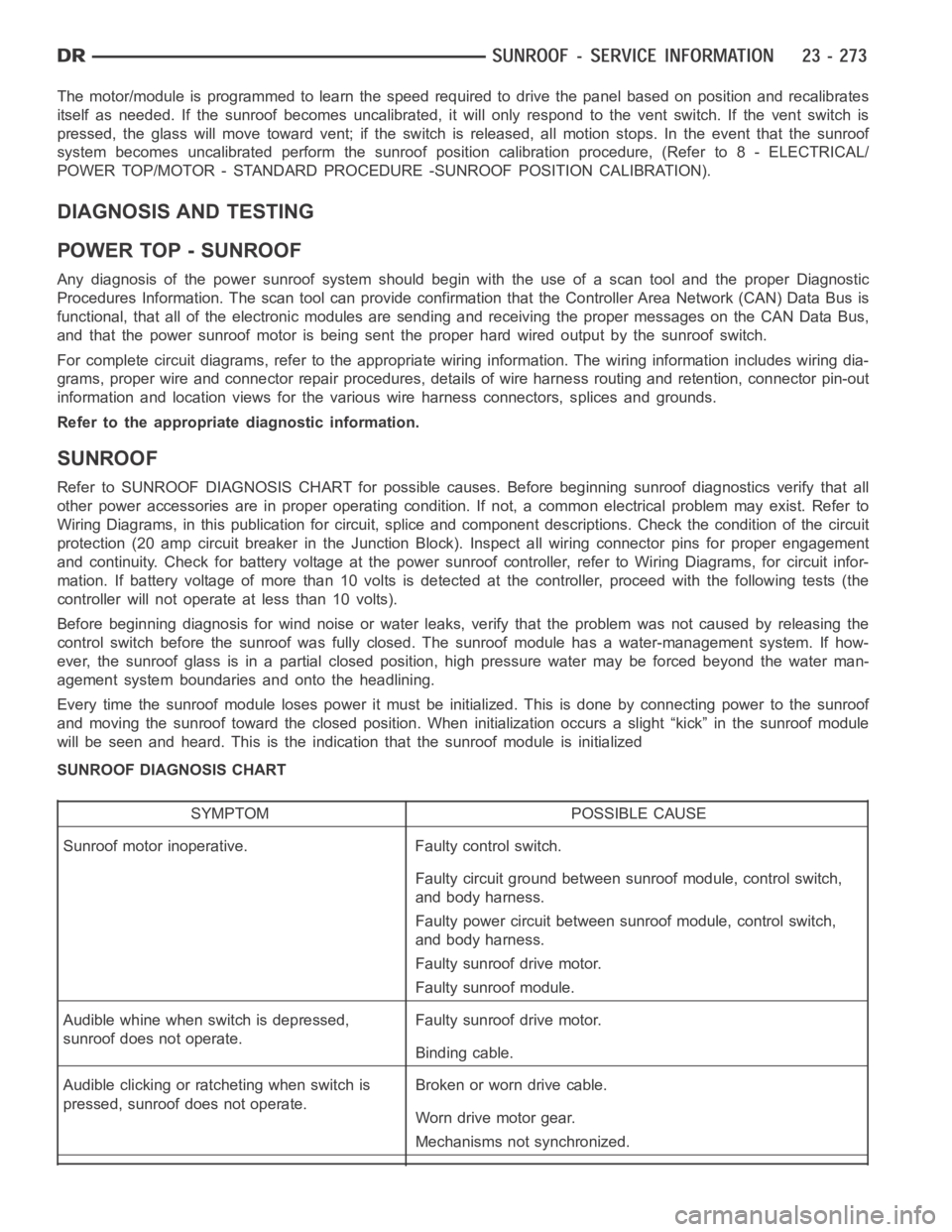
The motor/module is programmed to learn the speed required to drive the panel based on position and recalibrates
itself as needed. If the sunroof becomes uncalibrated, it will only respond to the vent switch. If the vent switch is
pressed, the glass will move toward vent; if the switch is released, all motion stops. In the event that the sunroof
system becomes uncalibrated performthe sunroof position calibration procedure, (Refer to 8 - ELECTRICAL/
POWER TOP/MOTOR - STANDARD PROCEDURE -SUNROOF POSITION CALIBRATION).
DIAGNOSIS AND TESTING
POWER TOP - SUNROOF
Any diagnosis of the power sunroof system should begin with the use of a scantool and the proper Diagnostic
Procedures Information. The scan tool can provide confirmation that the Controller Area Network (CAN) Data Bus is
functional, that all of the electronic modules are sending and receiving the proper messages on the CAN Data Bus,
and that the power sunroof motor is being sent the proper hard wired output by the sunroof switch.
For complete circuit diagrams, refer to the appropriate wiring information. The wiring information includes wiring dia-
grams, proper wire and connector repair procedures, details of wire harness routing and retention, connector pin-out
information and location views for the various wire harness connectors, splices and grounds.
Refer to the appropriate diagnostic information.
SUNROOF
Refer to SUNROOF DIAGNOSIS CHART for possible causes. Before beginning sunroof diagnostics verify that all
other power accessories are in proper operating condition. If not, a common electrical problem may exist. Refer to
Wiring Diagrams, in this publication for circuit, splice and component descriptions. Check the condition of the circuit
protection (20 amp circuit breaker in the Junction Block). Inspect all wiring connector pins for proper engagement
and continuity. Check for battery voltage at the power sunroof controller, refer to Wiring Diagrams, for circuit infor-
mation. If battery voltage of more than 10 volts is detected at the controller, proceed with the following tests (the
controller will not operate at less than 10 volts).
Before beginning diagnosis for wind noise or water leaks, verify that the problem was not caused by releasing the
control switch before the sunroof was fully closed. The sunroof module hasa water-management system. If how-
ever, the sunroof glass is in a partial closed position, high pressure water may be forced beyond the water man-
agement system boundariesand onto the headlining.
Every time the sunroof module loses power it must be initialized. This is done by connecting power to the sunroof
and moving the sunroof toward the closed position. When initialization occurs a slight “kick” in the sunroof module
will be seen and heard. This is the indication that the sunroof module is initialized
SUNROOF DIAGNOSIS CHART
SYMPTOM POSSIBLE CAUSE
Sunroof motor inoperative. Faulty control switch.
Faulty circuit ground between sunroof module, control switch,
and body harness.
Faulty power circuit between sunroof module, control switch,
and body harness.
Faulty sunroof drive motor.
Faulty sunroof module.
Audible whine when switch is depressed,
sunroof does not operate.Faulty sunroof drive motor.
Binding cable.
Audible clicking or ratcheting when switch is
pressed, sunroof does not operate.Broken or worn drive cable.
Worn drive motor gear.
Mechanisms not synchronized.
Page 4693 of 5267
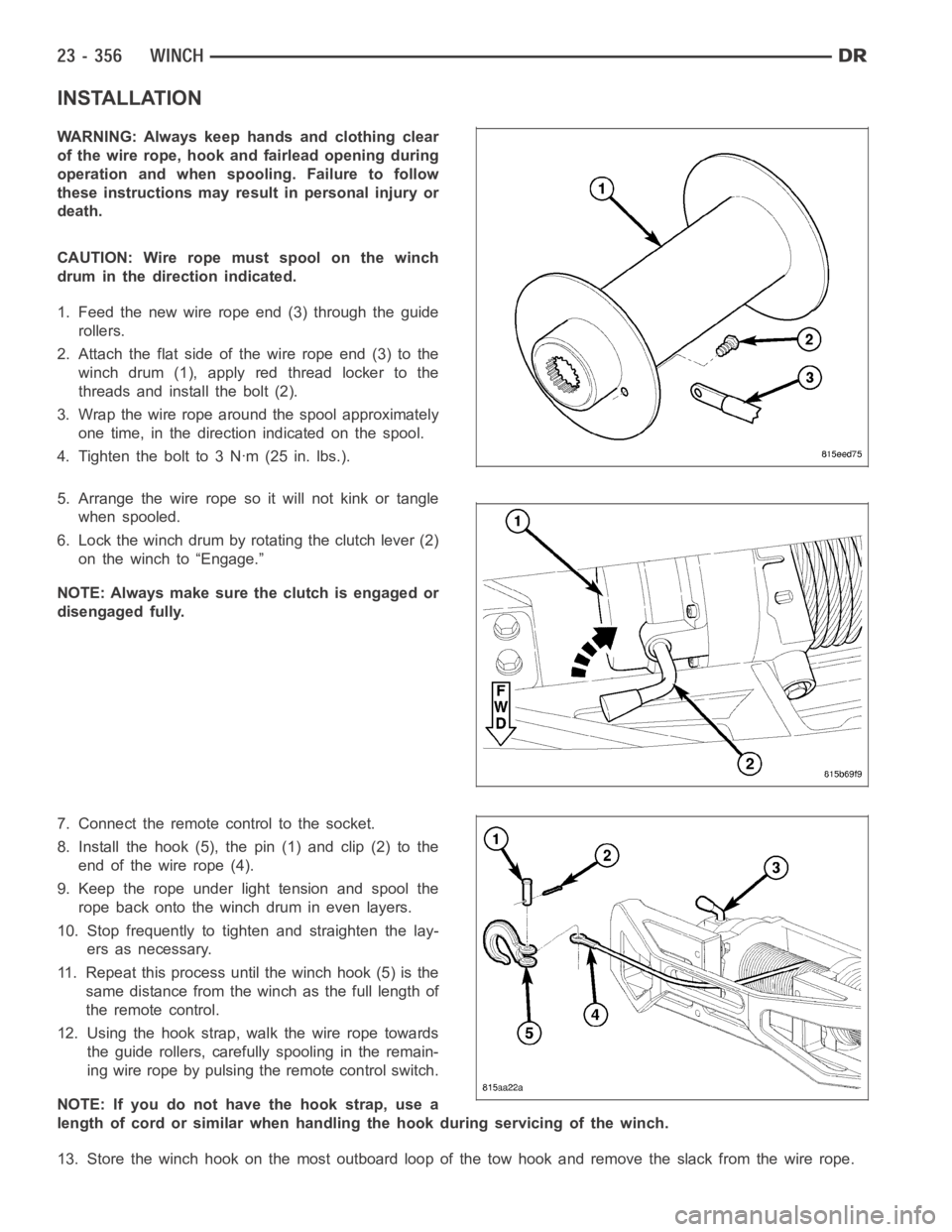
INSTALLATION
WARNING: Always keep hands and clothing clear
of the wire rope, hook and fairlead opening during
operation and when spooling. Failure to follow
these instructions may result in personal injury or
death.
CAUTION: Wire rope must spool on the winch
drum in the direction indicated.
1. Feed the new wire rope end (3) through the guide
rollers.
2. Attach the flat side of the wire rope end (3) to the
winch drum (1), apply red thread locker to the
threads and install the bolt (2).
3. Wrap the wire rope around the spool approximately
one time, in the direction indicated on the spool.
4. Tighten the bolt to 3 Nꞏm (25 in. lbs.).
5. Arrange the wire rope so it will not kink or tangle
when spooled.
6. Lock the winch drum by rotating the clutch lever (2)
on the winch to “Engage.”
NOTE: Always make sure the clutch is engaged or
disengaged fully.
7. Connect the remote control to the socket.
8. Install the hook (5), the pin (1) and clip (2) to the
end of the wire rope (4).
9. Keep the rope under light tension and spool the
rope back onto the winch drum in even layers.
10. Stop frequently to tighten and straighten the lay-
ers as necessary.
11. Repeat this process until the winch hook (5) is the
same distance from the winch as the full length of
theremotecontrol.
12. Using the hook strap, walk the wire rope towards
the guide rollers, carefully spooling in the remain-
ing wire rope by pulsing the remote control switch.
NOTE: If you do not have the hook strap, use a
length of cord or similar when handling the hook during servicing of the winch.
13. Store the winch hook on the most outboard loop of the tow hook and remove the slack from the wire rope.
Page 4697 of 5267
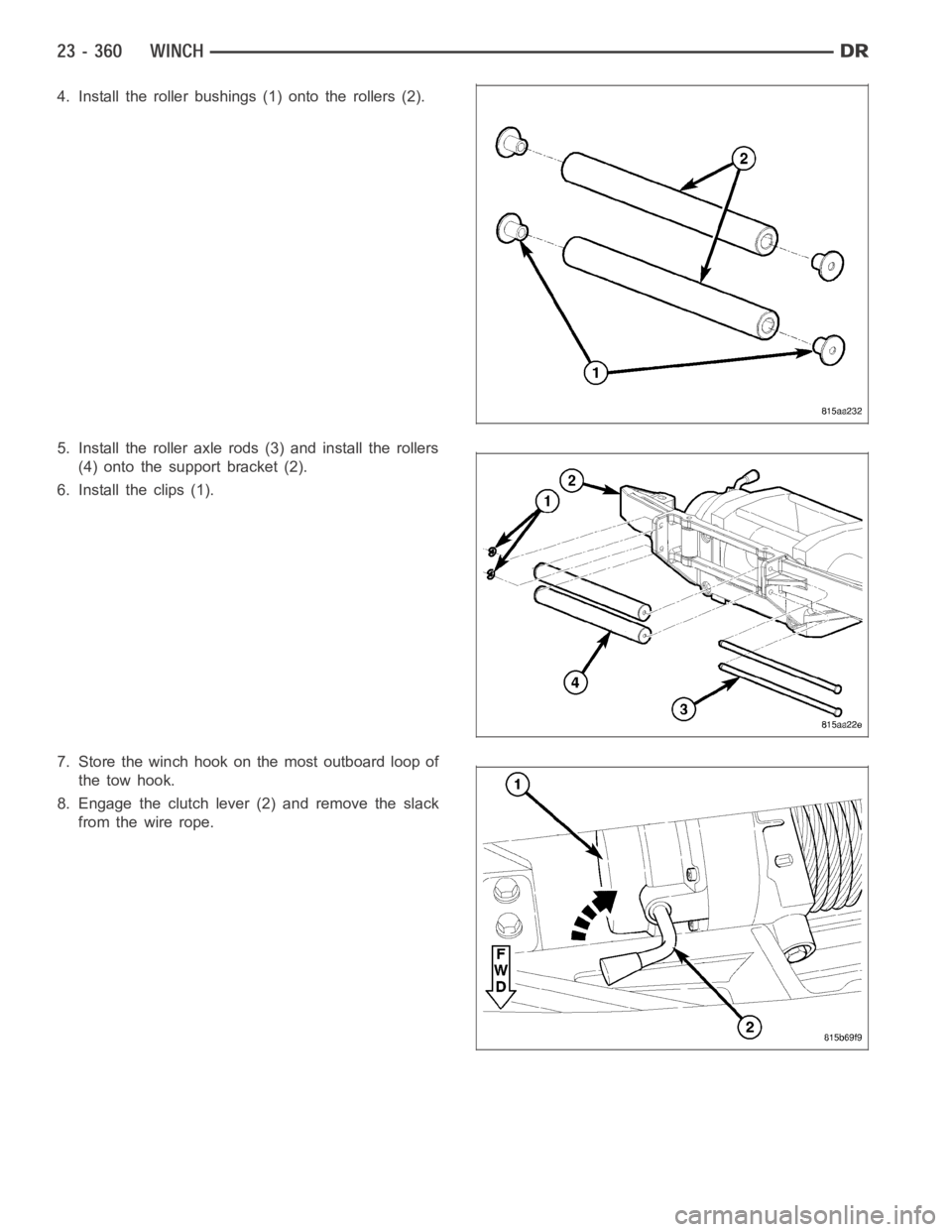
4. Install the roller bushings (1) onto the rollers (2).
5. Install the roller axle rods (3) and install the rollers
(4) onto the support bracket (2).
6. Install the clips (1).
7. Store the winch hook on the most outboard loop of
the tow hook.
8. Engage the clutch lever (2) and remove the slack
fromthewirerope.